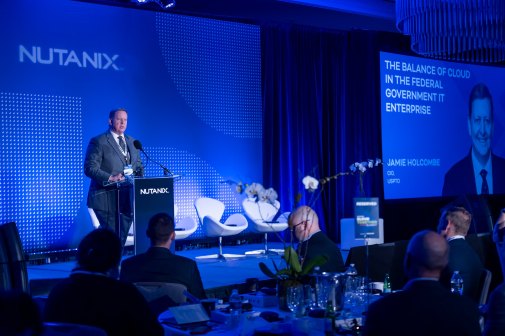New patent examiner system well received – CIO
Patent office examiners have given high marks to a new IT system meant to improve how the agency processes patent applications, officials told FedScoop.
“It has been well accepted. People have been excited. The union has been complimentary,” John Owens, chief information officer at the U.S. Patent and Trademark Office, said in his office at the agency’s Northern Virginia headquarters.
The agency two months ago rolled out Patents End-to-End, a platform that allows examiners to perform a range of tasks on one interface while they’re evaluating patent applications. So far, nearly half of the office’s 8,000 examiners have been trained on the system.
“They are asking us for more features and functions or better ways of doing things … and they aren’t really reporting bugs,” he said.
Owens said most patent examiners are tech-savvy engineers or scientists who are more apt to take to a new technology — and be forgiving of minor glitches. The trademarks side of the agency is a different story, he said: They might not be able to pinpoint what capabilities they want in a new platform, but they’re more intolerant of tech hiccups.
“Those are all lawyers, so they have to learn IT in a different way than a lot of engineers do,” he said.
A few years ago, the examiner workforce switched from desktop computers running Windows XP to more modern laptops with Windows 7. When Owens began training workers on the new system, he started with the design unit, the least technical division under patents. It was a mistake, he said.
“This time with Patents End-to-End, we decided to go with the tech-savvy people first,” he said. It builds confidence, he said, when workers hear positive things about a new system from colleagues.
When it slowly introduces a new system for trademark examiners next month, the CIO’s office plans to start with the more tech-minded e-business unit, Owens said.
Looking ahead, Owens said his office plans to introduce a new function on Patents End-to-End that would help examiners work with patent offices abroad on applications filed in several countries.
“Some countries are mailing hard drives and disks” to collaborate on prior art searches, Owens said.
He said the office plans to release a beta version of that system in fiscal year 2016 and a final version the next year.
Improving the office’s IT tools has been posed as a way to help the office cut into its nearly 600,000 patent application backlog. And USPTO Director Michelle Lee has suggested IT upgrades could help improve patent quality, which could make patent holders less susceptible to predatory firms that engage in frivolous law suits, known as patent trolls. Also Monday, lawmakers on the House Judiciary Committee marked up a bill that also aims to quash troll suits.
According to Owens, the office must run the old and new systems simultaneously for a year as the workforce adapts to the new system. The goal is to have all the examiners trained by mid-August.
The president of the Patent Office Professional Association, which represents the patent examiners, did not immediately respond to a request for comment on how workers have taken to the system.
USPTO hosts DevOps conference
The patent office developed the Patents-End-to-End system using a philosophy called DevOps, where development and operations teams to work together so they can more rapidly deploy new systems.
On Thursday, the agency hosted the area’s first DevOpsDays conference, which drew about 400 public and private sector IT staffers to the patent office’ headquarters. The two-day event continues Friday, when Citizenship and Immigration Services CIO Mark Schwartz and former FCC CIO Greg Elin are slated to speak.
In his introductory remarks at the conference, Owens talked about his agency’s efforts to execute a DevOps mentality. Deploying an efficient intellectual property system is essential, he said. Before the former AOL technical director came to the agency, Owens said he filed a patent application that took six years to get approved.
“Quite honestly six years to get a technology patent or in any computer science industry field was way too long,” he said.
Since then, he said he’s been trying to bring private sector ideas, like DevOps, into the agency.
“I came here to make this institution better,” he said.




